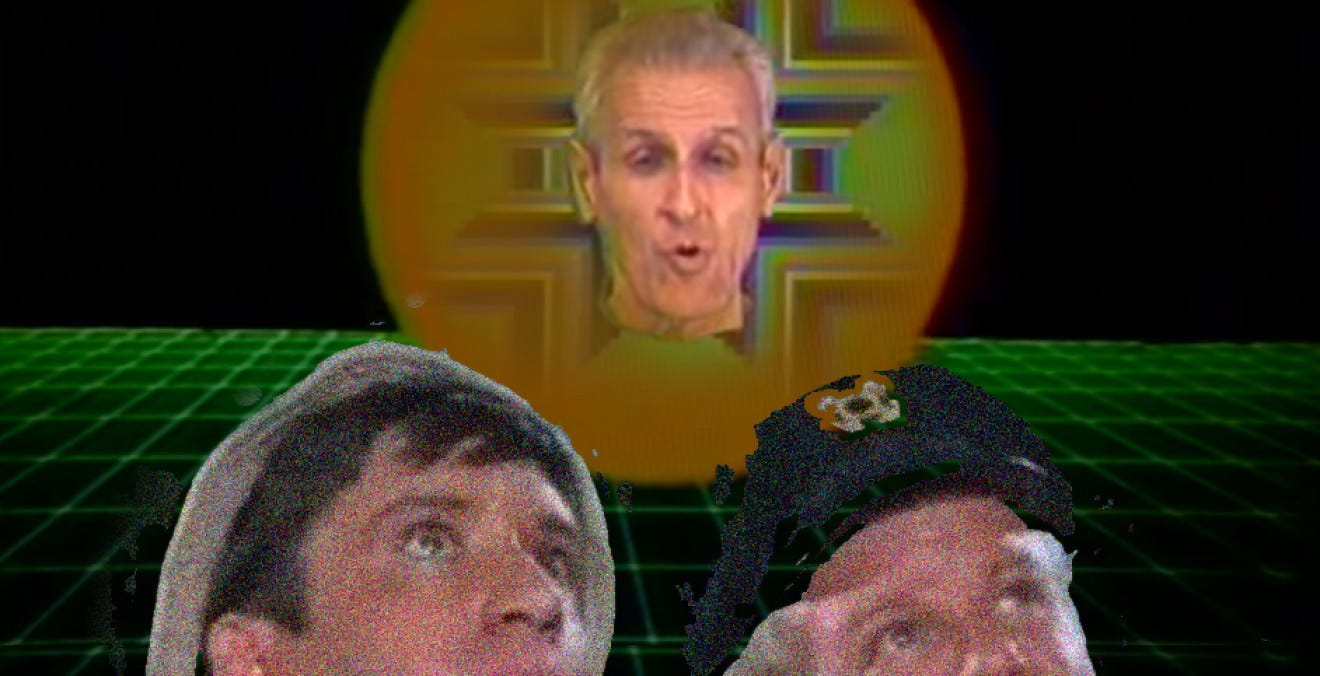Day 5: In Camera
Gilligan meets Jean-Paul Sartre
(VIDEO AT BOTTOM)
Finally, I'm back!
I didn't post anything the last 2 days as I was trying to fix a corrupted drive. Now I'm back to getting things uploaded. …and I will definitely do a Cauldron ad, or two, or three cut from this video.
Video installation can be difficult to share online, and this one is particularly difficult to appreciate in two dimensions. This installation was a solo show at the Utah Museum of Contemporary Art (UMOCA), and it included about 13 different video screens. Four of those screens interacted with each other to create a narrative arc. In order to experience that narrative arc, you had to situate yourself in the middle of the exhibit and turn your head from screen to screen as they interacted. The narrative is a walk through different philosophical topics (see the description below). I have edited the experience into two different videos. The first one shows how the exhibition looks physically, and the second one shows the entire narrative of those four screens. It was the best way I could think of to share the experience on a two-dimensional plane. If I were lecturing on this video, I would pause it at key points to explain underlying details, but I feel that is a bit much for this post and wouldn't really work and text form. The text below comes from my original artist statement on the piece, and also includes an excellent write-up by Brian Staker. It might help to read it before viewing the video, though I know that, just like in a gallery, most people won't read it and will just watch the video. Hope you all enjoy it.
In Camera
2015
Installation
IN CAMERA probes relationships between popular entertainment media, classic literature and dominant philosophical concepts of selfhood. Presenting an intentionally overstimulating array of video mashups, the installation simultaneously electrifies and oppresses the audience with equal parts absurd and meaningful discourse.
In this work, such prose as Jean Paul Sartre’s No-Exit finds itself implanted within the popular sitcom Gilligan’s Island. The works of Samuel Beckett, Albert Camus, and Friedrich Nietzsche are injected into a mixture of Hollywood films, and Eastern meditative practices and commercial amusements vie for our attention via sports broadcasts—and just once in a while, Jack Kevorkian appears on a screen and begins to explain perception.
IN CAMERA is both an exploration of and a statement on the struggle to maintain a balanced sensibility in the face of a gauntlet of tropes, memes, and dogmatic explanations about the nature of existence. Through this selection of fragmented narratives and televised programming, the installation reveals the ways in which screens dictate worldviews just as powerfully as any philosophical or spiritual belief.
---------------
From Salt Lake City Weekly:
Video artist Tyrone Davies is fascinated by taking video and film to their extreme limits, whether that takes his work to a place that seems logical or not. That work is very much informed by the ideas of the late Marshall McLuhan, who said "the medium is the message." Sound, literature and music are integral to the mix, as though media only exists in plural—synesthesia—and that's very McLuhan-esque, too.
The title reminds us of the Latin origins of "camera," from the root meaning "chamber." In the darkened echo chamber of UMOCA's Projects Gallery, Davies concocts a mashup of video images featuring Samuel Beckett, Albert Camus and Friedrich Nietzsche mixed with clips from Hollywood films, TV programs such as Gilligan's Island, Eastern meditations, commercials and even "right-to-die" activist Dr. Jack Kevorkian. The mixture is equal parts engaging and oppressive in its overstimulation, but also implies that elevated, academic ideas about selfhood, perception and identity are inextricably entangled with the detritus of pop culture. In fact, neither can exist without the other, since academia has to account for the effects of cultural change—and even fare like Gilligan's Island strives for a story that's on one level Homeric.
The multiplicity of fractured narratives, chopped up and layered as though intended to resonate with the observer almost subliminally, leaves viewers in a state of disorientation, with the uncanny sensation that the medium is doing a number on them, not leaving them the same as when they entered. (Brian Staker)
SHARE THISOPP(c) TYRONE DAVIES



Anything with Gene Hackman.